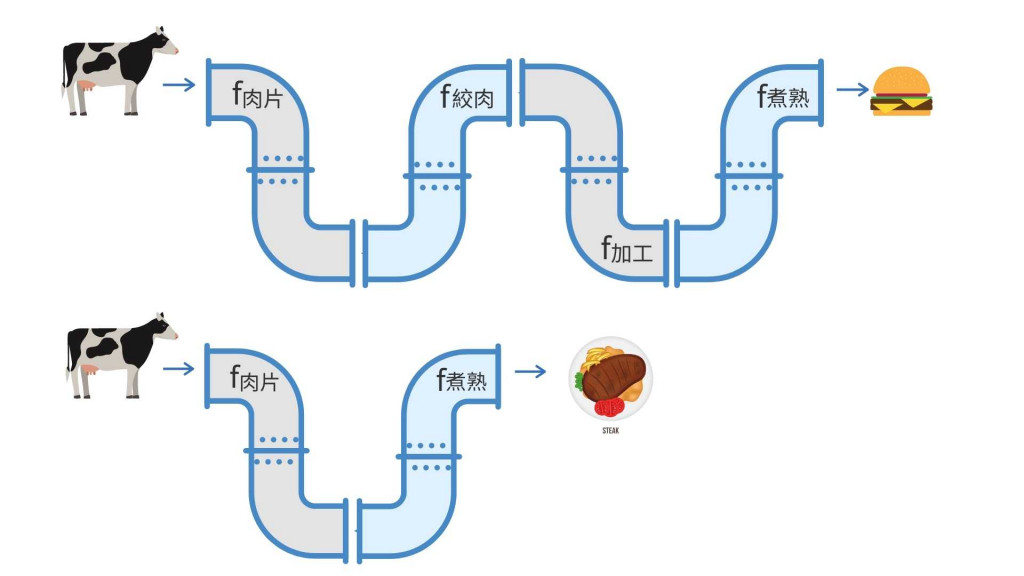
接下來的練習想直接用 Ramda.js 因為會簡潔很多,所以這一篇先來簡單介紹一下 Ramda
A practical functional library for JavaScript programmers.
Ramda 是一個 Library ,可以把 Ramda 想成 functional programming 界的 lodash 或 underscore 。
Ramda 的 API 很豐富,而且大部分 API 也很直覺,不需要花太多時間理解。但你可能會覺得我用 loadash 就好,為何要多學一個?最大的差別在於
有著自動轉 Curry 與 "Function first,Data last" 特性好處非常非常多,也很符合 Pointfree style (之後文章會介紹),簡而言之就是能讓功能獨立切開再組合成想要的樣子。
It's very easy to build functions as sequences of simpler functions, each of which transforms the data and passes it along to the next.
就像前一篇曾經出現的例子,每一個 function都像是一個小水管獨立處理不同的事,只要有不同排列組合下就可以輕易得到不同結果

如以上所說的 "function first,data last",Ramda 第一個參數一定為函式,後面才是資料
_.函式名稱(函式, 資料)
const _ = R;
const odd = x => x%2 === 1
const data = [3, 5, 6];
_.filter(odd, data); // [3, 5]
另外 Ramda 會幫你把所有函式 Curry 化,所以你要這樣寫也可以
_.filter(odd)(data); // [3, 5]
// 或是也可以這樣寫
const filter1 = _.filter(odd);
const filter2 = filter1(data)
若以上轉成一般寫法的話大概會是這樣,比較繁瑣些
const _curry = f => a => b => f(a, b)
const _filter = _curry( (fn, arr) => arr.filter(fn) );
const result = _filter(odd)
console.log(result([3, 5, 6])) // [3, 5]
這邊只先介紹之後幾篇會用到的 Ramda API
filter: 過濾出符合條件的成員
const isEven = n => n % 2 === 0;
R.filter(isEven, [1, 2, 3, 4]); //=> [2, 4]
R.filter(isEven, {a: 1, b: 2, c: 3, d: 4}); //=> {b: 2, d: 4}
reverse: 反轉
R.reverse([1, 2, 3]); //=> [3, 2, 1]
R.reverse([1, 2]); //=> [2, 1]
R.reverse([1]); //=> [1]
R.reverse([]); //=> []
R.reverse('abc'); //=> 'cba'
R.reverse('ab'); //=> 'ba'
R.reverse('a'); //=> 'a'
R.reverse(''); //=> ''
map: 成員依次執行某個函式
const double = x => x * 2;
R.map(double, [1, 2, 3]); //=> [2, 4, 6]
R.map(double, {x: 1, y: 2, z: 3}); //=> {x: 2, y: 4, z: 6}
last: :返回最后一个成員
R.last(['fi', 'fo', 'fum']); //=> 'fum'
R.last([]); //=> undefined
R.last('abc'); //=> 'c'
R.last(''); //=> ''
add: 返回兩個值的和
R.add(2, 3); //=> 5
R.add(7)(10); //=> 17
multiply: 返回兩個值的積
R.multiply(2)(5) // 10
prop: return 指定的屬性
R.prop('x', {x: 100}); //=> 100
R.prop('x', {}); //=> undefined
R.prop(0, [100]); //=> 100
R.compose(R.inc, R.prop('x'))({ x: 3 }) //=> 4
compose: 將多個函式合併成一個函式,右到左執行
R.compose(Math.abs, R.add(1), R.multiply(2))(-4) // 7
pipe: 將多個函式合併成一個函式,左到右執行
var negative = x => -1 * x;
var increaseOne = x => x + 1;
var f = R.pipe(Math.pow, negative, increaseOne);
f(3, 4) // -80 => -(3^4) + 1
curry: 將多個參數轉變為單一參數
const addFourNumbers = (a, b, c, d) => a + b + c + d;
const curriedAddFourNumbers = R.curry(addFourNumbers);
const f = curriedAddFourNumbers(1, 2);
const g = f(3);
g(4); //=> 10
Ramda 本身的 API 相當豐富,也可以搭配 compose/pipe 自由組裝自己的 function,並且利用以上提到方法來簡化函式。
如有錯誤或需要改進的地方,拜託跟我說。
我會以最快速度修改,感謝您
歡迎追蹤我的部落格,除了技術文也會分享一些在矽谷工作的甘苦。

 iThome鐵人賽
iThome鐵人賽
 看影片追技術
看更多
看影片追技術
看更多